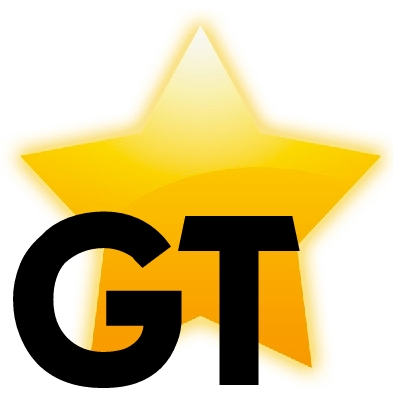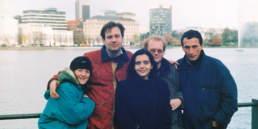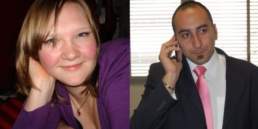“Vooch. Once again, everybody: Vootch.” The President of the new AEGEE local in the Polish city Lódz refused to sign the Convention d’Adhésion, before every single delegate in the huge conference hall in Eindhoven pronounced the name of her city in the correct way: “Vooch”. This was only one of many highlights of the Presidents’ Meeting (PM) in Eindhoven, which took place from 1st to 3rd of March 1996.
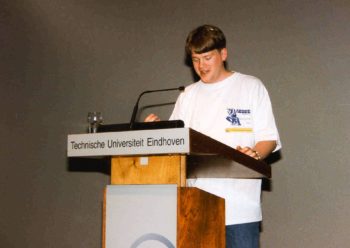
The most participants, the highest number of participating locals, the biggest event of AEGEE-Eindhoven: the spring Presidents’ Meeting broke three records. “We were really proud to turn this statutory event into a big success”, recalls Michiel van Hees, President of AEGEE-Eindhoven and main organiser. Altogether 450 students from 100 AEGEE branches attended the PM.
You are not familiar with the term Presidents’ Meeting? Well, from 1986 to 2000 this was the name of the small brother of the Agora, later called Planning Meeting, then European Boards’ Meeting (EBM) and since last year European Planning Meeting (EPM). While todays EPM’s role is mainly to discuss an issue of special importance during a conference part and also to prepare the Action Agenda of AEGEE, formerly known as Yearplan, the Presidents’ Meeting was preparing the Agora – which also included discussions about future activities and projects.
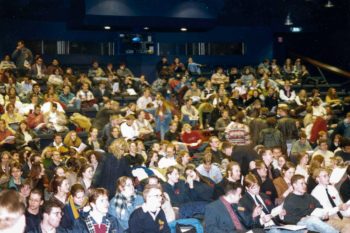
With this high number of participants the event actually resembled more an Agora than a usual PM. In fact, AEGEE-Eindhoven, known for doing things in style and sometimes also showing off a bit with it, could have easily pulled off organising an Agora, which had more prestige in the network. However, they decided to go for a PM on purpose. “Presidents’ Meeting sounded cooler than Agora”, says Michiel van Hees, who was awarded Honorary Membership of AEGEE-Europe in 2002 – for his various activities from organising projects to creating AEGEE.tv.
The PM in Eindhoven was not only special in size, but also in quality. Excellent meeting facilities, low fees and short ways to all buildings contributed to the fantastic atmosphere, which was generated by a team of very friendly and professional organisers. A special highlight: “Our Technical University supported us with money from a special fund, so we could arrange three buses for 120 participants from Central and Eastern Europe – nearly for free”, reports Michiel van Hees.
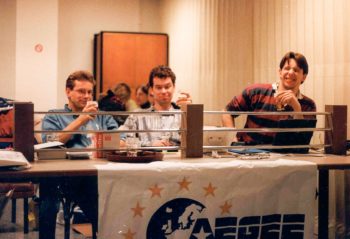
I wasn’t on these buses, but travelled in another way, which I will never forget: we were four people from AEGEE-Göttingen, crammed together in a very old Trabi. Our antenna president, Peggy Repennig, originated from Eastern Germany, and owned one of those infamous trademark cars of Socialist Germany. After 1990 you could basically get them for free, often they were just abandoned at the side of the road, and Peggy was still driving one of them, when she studied in Göttingen. The car was very old and we were afraid it would not make it to Eindhoven.
And in fact, it didn’t. Right when we reached the city limits of the Dutch city, the car broke down. Fortunately the university wasn’t far anymore. I went straight to the office of the antenna, where I was expecting to see nervous organisers running around, shouting at each other, lamenting a possible failure of the event. Because that’s how it was in Budapest, four months earlier, when the Hungarian antenna organised the Agora. Instead, there were just four guys sitting in the AEGEE-Eindhoven office, being totally relaxed, playing computer games, checking their mails, chit-chatting. “This is incredible. Don’t you have to organise an event?”, I asked. Michiel van Hees just smiled. “Everything is ready for weeks”, he replied.
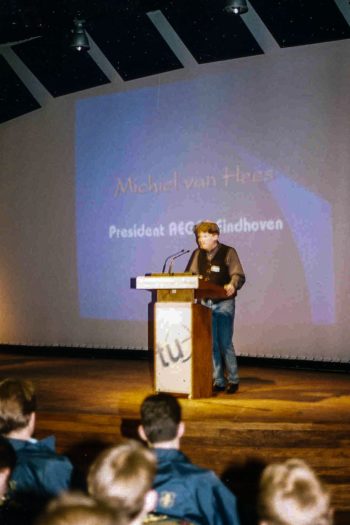
And indeed it was. In an impressive way! Thanks to the great financial and logistical support of the Technical University of Eindhoven, and due to the fact that this city was the seat of Philips, the building and its technical facilities were state of the art. For example, this was the very first statutory event, where the organiser used a beamer instead of an overhead projector. We were all so impressed! Right until 2000, overhead projectors were still used at Agoras and PMs.
But how was the programme like? It was very different from today’s EPM. It started on Friday at noon with a speed course for fresh members. Today’s AEGEE Fair was called Working Group Fair and lasted 30 minutes. Working Groups with dozens of members played a big role in AEGEE, before they were deleted in 2015 and partially refounded as Interest Groups, being replaced by new Working Groups with restricted membership. After the Working Group Fair the Culture WG, Europe of the Regions WG, Jobfair WG, Education WG, East-West WG, North-South WG, Environmental WG, Human Rights WG and the Public Relations WG invited the participants for working group meeting sessions, which were visited by many people. This was a very good concept: the Fair made the participants curious and since there was no alternative programme, many people joined the WG sessions right afterwards and became active. Actually, the fact that the exclusive timeslot for working groups at statutory events was abolished might have played the decisive role in their downfall.
And that’s it with Friday’s programme. In those days opening ceremonies as today were not standard. Organisers could make them, but it was not required. The opening took place in the plenary on Saturday morning. What followed then at the PM, looks like an Agora Light programme: in the morning the CD presented their Moral Report. Today this is called Activity Report, so that members do not get the idea that the report is about ethic conduct of the CD.
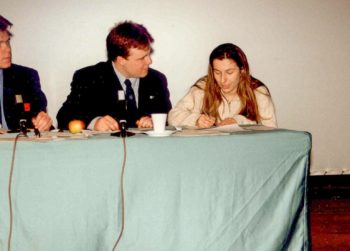
The Presentation of the Moral Report was extremely important. It gave a great indication about how the CD was doing and helped the locals to prepare for the Agora – sometimes this meant: sharpening their knives. In Eindhoven, AEGEE-Europe’s President Christoph Strohm had many highlights to present. Just two months earlier the headoffice of the association had moved from Delft to Brussels. “Our other big successes include the participation at the EU’s Single Currency Round table in Brussels and a photo exhibition at the Council of Europe in Strasbourg”, he summarised. Christoph Strohm stressed that AEGEE should take more actin in organising bigger thematic projects, such as organising a conference cycle around the Euro currency and East-West projects.
This report was followed by a thorough question and answer session and workshops in the afternoon. Those workshops were mostly about projects, but also internal issues. For example: after holding the HRWG session on Friday, whose president I was back then, I had a workshop on Saturday about the Case Study Trip to former Yugoslavia, which our working group had planned for autumn. Other workshop topics were for example about AEGEE trainings or participation fees for statutory events.
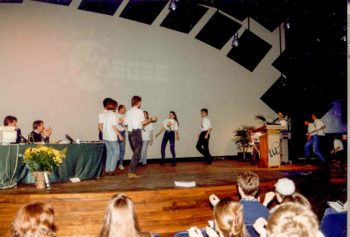
On Saturday evening there was a meeting for potential CD candidates, just like today, and a Partnership Fair. If you now think this is related to the infamous pointsystem, then you are wrong. The Partnership Fair was for antennae who were looking for a twin – although the name “twin antenna” did not exist yet and the process was not formalised either. However, also this Fair is an interesting concept which got forgotten in time.
The Sunday programme again resembled the Agora schedule: the CD presented the Financial Report, followed by a question round – and elections! Yes, indeed! Despite the fact that the PM was not the Agora, it had the power to elect people for one specific European body: the Members Commission. But only for half of it; the other half was elected at the Agora.
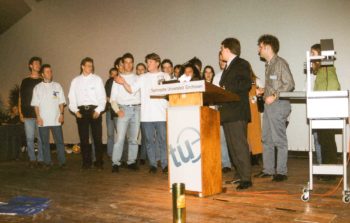
In case you joined AEGEE in the past couple of years, you know this body as Mediation Commission. In fact, the name Members Commission confused a lot of people, even candidates. As a result, there was always someone who asked the candidates: “Can you explain what the Members Commission is doing?” This resulted often in funny-embarrassing moments, because there was usually always someone who said: “The Members Commission takes care of the people in AEGEE.” They did not know that members of AEGEE usually refers to locals. This time there was one special candidate: Eric Cherel from AEGEE-Vannes, whose antenna was under investigation for forging the signature of the President of AEGEE-Europe and bullying another antenna. With his candidature he tried to influence the case. Of course the delegates understood this and Eric got only 2% of the votes.
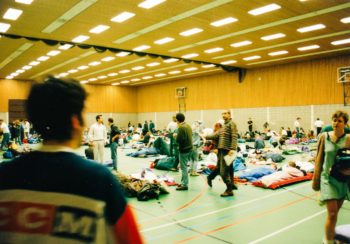
The rest of the days were workshops again – some of them were dealing with issues which became proposals at the next Agora, others were about the Yearplan and other projects – and the signing of the aforementioned Convention d’Adhésion. Five contacts became Contact Antennae: Dunaújváros, Lódz, Gießen, Split and Strasbourg. And three Contact Antennae were upgraded to Antennae: AEGEE-London, AEGEE-Rijeka and AEGEE-L’viv. There was plenty of time to get to know the latest members, also due to the less crowded agenda than at Agoras – following the old motto: “Agoras are for making decisions, PMs are for making friends.”
